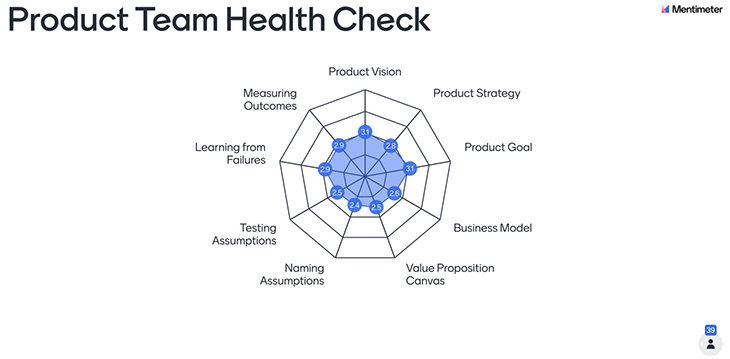Teams can only succeed with scrum if they go beyond it.

Over the last decade, scrum has seen a significant rise in adoption. Today, it’s one of the most well-known and widely used agile frameworks.
Scrum provides a simple way for teams to work together to create value incrementally. Who wouldn’t want that?
The trouble is, virtually everyone falls into common scrum traps and antipatterns, such as:
It’s easy to fall into those antipatterns, but that’s not what scrum is truly about. How did we get here?
Scrum isn’t evil by design; it’s actually quite helpful. The evil part lies in the interpretation. It’s like a game of telephone — by the end, it’s nothing like what it’s supposed to be.
I must be clear. You’ve got no chance of thriving with scrum alone. You must add the correct elements to it.
Let me elaborate on why teams miss the mark and become feature factories instead of empowered teams.
It’s a mistake to rely solely on scrum. Don’t take my word on it, have a look at the Scrum Guide:
The scrum framework is purposefully incomplete, only defining the parts required to implement scrum theory. Scrum is built upon by the collective intelligence of the people using it.
Purposefully incomplete. Please, don’t forget that. But what does that mean? Simply put, you’ve got to add something to succeed with scrum, and that’s the danger zone.
Purists will fail because scrum isn’t ready to guide teams to create value thoroughly.
Scrum creates room for fundamental interactions to happen. Also, it helps strengthen collaboration inside the organization when done right. But the framework won’t answer any of the following questions:
You’re on your own. You’ve got to figure out how to answer these questions without scrum. And that’s OK. Scrum never promised to answer any of these, but many people still perceive the framework as the whole grail of agile.
I’ve said something a thousand times, but I cannot emphasize that enough:
Scrum is a means to an end. The goal is to create value, not to do scrum.
If scrum is incomplete, what should you add to make it possible to thrive with digital products? Well, it depends. It’s not black and white because scenarios and business play a role. But I’d say some key elements are pretty standard and work across industries.
Some months ago, I talked at Agile to Agility and was quite surprised when I asked about the status quo of scrum teams. I wanted to understand what teams use. Please, have a look at the following image:

Product Health Check — Keynote Agile to Agility — by David Pereira.
As you can see, the usage of crucial product management elements was quite limited with the event’s audience. Was that an exception or a reflection of common traps? Unfortunately, that’s what I commonly see with scrum teams.
They aim to create value faster but miss out on critical elements to enable that.
Let me explain to you what I perceive to be critical elements to enable you to succeed with digital product management:
What do you envision achieving? A compelling product vision inspires the team and makes the direction clear. You know the problem you solve, why that matters, and how to differentiate.
Vision alone isn’t enough. You’ve got to craft a strategy to enable you to reach your vision. Who’s your target audience? How do you delight them? Which trade-offs are you willing to make? A valuable product strategy enables teams to focus and make daily decisions faster.
Once you have a sharp vision and guiding strategy, you must define what to focus on next. Product goals represent steps toward your vision. It’s something achievable in a couple of months.
Understanding how to connect the dots of your business is important. Decisions become arbitrary and potentially misleading if you don’t understand the big picture. I like using Business Model Canvas or Lean Canvas. They are straight to the point and give an amazing overview.
How deeply do you know your customers? Do you understand their jobs, pains, and gains? Without that, you’re relying on luck, and that’s a horrible choice. Crafting a value proposition won’t take long, but lacking it will lead to long-lasting mistakes.
Falling in love with an idea is easy, but getting it right is hard. Stepping back and naming assumptions we have is critical to success. I like asking, “what could go wrong?” Then, I work backward to test the assumptions. Not doing it is like driving a car without seeing the road; it’s just a matter of time to crash.
Naming assumptions isn’t enough. You need to test the critical ones. The main aspect is knowing that you don’t need to test everything but the ones vital for business success. The quicker you test, the faster you learn. Nowadays, we’re lucky because you’ve got many options to test ideas instantly.
Failure isn’t bad. It’s just a natural step toward success. Traditionally, people think that failing is final. That’s why they avoid it at all costs. But, without failures, you won’t learn how to create value faster. The challenge is creating small experiments, learning from failures as small as possible, and then adapting your steps towards them.
Delivering features doesn’t mean creating value. How do you know when something created value for users? You can only learn that if you measure the results. It’s essential to figure out how to measure results as fast as possible. This will enable you to create what matters.
The goal of scrum is to maximize value, but often you can’t do that with scrum alone. Scrum is great for helping teams uncover blind spots, but when it comes to creating value, you must go beyond the framework.
One of the biggest dangers with scrum is falling into execution mode. This will ensure the teams become feature factories and miss the mark. To avoid that, you should focus on product discovery.
You will find dozens of ways of making product discovery, and most of them will be noise. A great approach is to follow the continuous discovery habits espoused by Teresa Torres. As you master product discovery, you’ll increase your odds of delivering value faster.
I must emphasize that discovery and delivery are inseparable; if you try to separate them, you risk diminishing accountability. Teams should be accountable from end to end.
Another challenge is prioritization and decision-making. Scrum requires sharp focus. Otherwise, your teams get distracted and create little value. I encourage teams to simplify decision-making and ensure progress. A great way of doing that is to use the decision-stack framework by Martin Erikson.
When you implement the decision stack framework, your teams will understand what matters and how to connect their daily work to the big picture. Skip that, and you will face endless discussions and decision paralysis.
The digital product world is exciting and exhausting. Don’t expect to find shortcuts to create state-of-the-art products in the blink of an eye. Expect to hit the wall several times before you make something meaningful.
You won’t find a perfect success recipe, but you can increase your chances of thriving by adding essential elements to your game. What I shared with you is what worked for me across many industries. It might work for you too, but don’t limit your game to what I shared. Develop a learning mindset and adapt according to your discoveries.
In the digital product world, change is the only certainty.
Featured image source: IconScout

LogRocket identifies friction points in the user experience so you can make informed decisions about product and design changes that must happen to hit your goals.
With LogRocket, you can understand the scope of the issues affecting your product and prioritize the changes that need to be made. LogRocket simplifies workflows by allowing Engineering, Product, UX, and Design teams to work from the same data as you, eliminating any confusion about what needs to be done.
Get your teams on the same page — try LogRocket today.

Most teams fail at autonomy. Learn how clear rules help product teams move faster without micromanagement.

A practical framework for PMs to use AI in ideation without sacrificing judgment, strategy, or decision quality.

A practical five minute revenue estimation method to help product managers compare ideas, drop low impact features, and prioritize smarter.

A practical guide for PMs who want to stop being bottlenecks, delegate smarter, and lead teams effectively with a clear ownership framework.